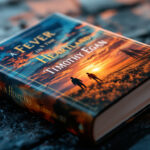Fahrenheit 451 by Ray Bradbury – A Review on Censorship and Society
What happens when a society decides books are dangerous? Ray Bradbury’s Fahrenheit 451 confronts this chilling possibility. Published in 1953, this dystopian classic imagines a future where firemen ignite flames instead of extinguishing them, burning books to suppress ideas. With its sharp critique of censorship and the overreach of technology, Bradbury’s novel remains deeply relevant. If you’ve ever wondered about the cost of silencing stories, this book offers a powerful exploration of what humanity stands to lose.
The Plot: A World Without Books
In Ray Bradbury’s Fahrenheit 451, readers are thrown into a haunting world where books are banned and “firemen” are tasked with burning them. This dystopian society thrives on censorship, entertainment, and ignorance, leaving no space for curiosity or individuality. At the core of this oppressive world is Guy Montag, a fireman whose journey reveals the dark consequences of a life devoid of literature and critical thinking. Let’s break down his story and the crucial characters who influence his transformation.
Guy Montag: The Fireman with a Dilemma
Guy Montag starts as a loyal servant of this dystopian system, dutifully burning books and reveling in the power of destruction. His role as a fireman isn’t just his job—it defines his identity. But beneath his uniform and mechanical routines, Montag feels a subtle discontent—a spark he cannot quite extinguish.
This inner conflict escalates when he meets Clarisse, a young woman full of curiosity and life. She questions the norms Montag has accepted his whole life: Why doesn’t he read the books he burns? Is he truly happy? These simple questions plant doubts that grow into a full-blown crisis of identity. Montag’s turning point arrives when he witnesses an old woman choose death over life without her cherished books. The sight of her fiery martyrdom shakes him to his core, pushing him to secretly pocket a book and begin his dangerous exploration of knowledge.
For more on the significance of Montag’s role, you might find this review insightful, as it touches on the intensity of his transformation and the societal critique Bradbury weaves into his story.
The Role of Clarisse and Mildred
Two pivotal women shape Montag’s journey in opposite ways. Clarisse McClellan, his young, eccentric neighbor, acts as the catalyst for his awakening. With her love of conversation and her fascination with the simple beauties of life, she represents everything missing from the bleak, shallow culture around them. Clarisse’s genuine curiosity makes Montag question his purpose and ignites his yearning for a deeper, more meaningful existence.
In stark contrast, Montag’s wife, Mildred, embodies the desensitized, entertainment-addicted society Bradbury critiques. Consumed by her interactive TV walls and reliance on sleeping pills, Mildred represents the dangers of escapism and superficial connection. She’s a cautionary figure, showing how a life of distractions can strip people of their humanity and empathy. Through these opposing characters, Bradbury illustrates the choice everyone faces: embrace curiosity and growth like Clarisse, or remain numb and stagnant, like Mildred.
For a closer look at how Bradbury uses these characters to highlight key themes, check out this detailed analysis of Fahrenheit 451’s themes.
The Climax and Montag’s Transformation
Montag’s internal struggle reaches a boiling point when his fire chief, Beatty, discovers his secret stash of books. Forced to torch his own home at Beatty’s command, Montag’s rebellion fully ignites—both figuratively and literally—when he turns the flamethrower on Beatty himself. This moment marks the complete breakdown of Montag’s old life and his irreversible decision to fight against the oppressive system.
From here, Montag becomes a fugitive, fleeing the city and finding solace among a group of intellectual outcasts. These “book people” dedicate their lives to preserving literature by memorizing entire works, ensuring that stories survive even in a world determined to erase them. Montag’s journey of transformation is a compelling reminder that freedom of thought and knowledge are worth fighting for, even when the cost is high.
For more about the deeper meaning of Montag’s rebellion, take a look at this comprehensive analysis of themes and symbolism.
Montag’s evolution—from a fireman who burns books to a man who seeks knowledge at any cost—offers a striking exploration of the human spirit in the face of oppression. Each challenge he faces paints a vivid warning about the dangers of censorship and the irreplaceable value of literature in shaping free thought.
Key Themes in Fahrenheit 451
Ray Bradbury’s Fahrenheit 451 offers timeless insight into the pitfalls of society through its exploration of censorship, shallow entertainment, and technological control. The book’s themes resonate strongly with the modern world, making it a cautionary story about the fragility of intellectual freedom and the human connection.
Censorship and Intellectual Freedom
At its heart, Fahrenheit 451 warns against the suppression of knowledge. In the story, books are burned to eliminate conflicting ideas and ensure conformity. But what happens when a society silences its thinkers? Bradbury’s message is clear: censorship creates a world devoid of curiosity, individuality, and the ability to question authority.
The novel shows how this oppressive system doesn’t just ban books; it destroys the essence of human growth. Montag’s transformation from an obedient fireman to a seeker of truth underscores the danger of restricting intellectual freedom. The act of reading becomes a radical tool of resistance, a way to preserve critical thinking in an era of ignorance.
This theme isn’t just fictional. History has repeatedly shown the consequences of stifling expression. For example, consider how authoritarian regimes have used censorship to control narratives and suppress dissent. For more insights into censorship’s impact, explore this analysis on intellectual freedom in Fahrenheit 451. It captures how Bradbury masterfully illustrates this chilling reality.
Entertainment vs. Meaningful Engagement
The society in Fahrenheit 451 prioritizes shallow distractions over meaningful conversations or self-reflection. From wall-sized TVs to fast-paced media, Bradbury paints a bleak picture of a culture addicted to hollow entertainment. The citizens’ obsession with instant gratification leaves no room for thought-provoking exchanges or personal growth.
Take Montag’s wife, Mildred, for example. She spends her days glued to “parlor walls,” completely disconnected from her husband and reality. Her allegiance lies with her virtual “family,” not the tangible world around her. This shallow engagement creates a void that no amount of entertainment can fill. It’s the reason why characters like Mildred seem so empty, while those like Clarisse, who seek genuine human connection, shine.
The parallels between Bradbury’s vision and today’s media-saturated environment are striking. Consider how social media and endless streams of content sometimes steer us away from deeper, more fulfilling interactions. To explore this theme further, take a look at Bradbury’s critique of societal distractions.
Bradbury’s Vision of Technology’s Role
Technology plays a dual role in Fahrenheit 451—a source of convenience and a method of control. Bradbury was eerily prophetic in predicting the rise of technologies like interactive screens and virtual reality. But he also foresaw their darker side: the potential to isolate individuals and suppress dissenting ideas.
Take the “seashell radios,” small earbuds that keep individuals perpetually distracted, cutting them off from genuine interactions. Combined with the interactive TV walls, technology creates a population conditioned to conform and accept whatever narrative they’re fed. It’s a stark reminder of how tools designed to connect us can also be used to distance and control.
Bradbury’s critique is especially relevant in an age where algorithms dictate what we see and hear. The novel encourages readers to think critically about technology’s power and its consequences. For more context, check out this detailed examination of technology in Fahrenheit 451.
By weaving these themes together, Fahrenheit 451 challenges us to recognize the importance of free thought, meaningful connection, and mindful use of technology. It’s an enduring reflection of the choices we make as a society.
The Characters: Symbols of a Society in Conflict
In Fahrenheit 451, Ray Bradbury doesn’t just create characters; he builds symbolic representations of a society on the brink of collapse. Each figure in the story embodies different reactions to the repressive culture they live in, from blind conformity to quiet rebellion. Let’s explore three key characters and the roles they play in this dystopian nightmare.
Captain Beatty: The Enforcer of Censorship
Captain Beatty is a fireman with a disturbingly deep knowledge of literature—a paradox that makes him one of the novel’s most intriguing figures. On the surface, Beatty appears to be fiercely committed to the government’s mission of censorship, relishing his role in burning books and silencing intellectual thought. But his actions reveal a more complicated truth. Beatty quotes Shakespeare and other literary greats, hinting at a time when he valued knowledge. Why, then, does he so vehemently oppose it now?
It seems Beatty’s relationship with books is rooted in resentment. Perhaps overwhelmed by their contradictory ideas or the loneliness intellectualism can bring, he has embraced the simplicity of censorship. He becomes the living embodiment of a society that has chosen ignorance over complexity. His fiery demise at Montag’s hands is poetic justice; a man who used fire to control others ultimately meets his end through it.
For a deeper dive into Captain Beatty’s contradictions, check out this insightful take on his character from SparkNotes or explore further here.
Clarisse McClellan: The Spark of Change
In a grim world obsessed with mindless entertainment, Clarisse McClellan shines as a beacon of curiosity and free thought. Clarisse is unlike anyone else Montag has encountered. She notices the small details—like the way leaves fall or how the world smells after rain—and draws Montag out of his robotic existence. Her love for life is contagious, and her deep questions about happiness and purpose spark something previously dormant in Montag.
Clarisse’s importance lies not just in what she represents, but in what she inspires. She challenges societal norms without fear, serving as a catalyst for Montag’s rebellion against the system. While her untimely disappearance is tragic, her influence lingers, proving that even the smallest acts of defiance can create ripples in an otherwise stagnant society.
Learn more about how Clarisse epitomizes individuality and hope by visiting SparkNotes or CliffsNotes.
Mildred Montag: The Tragic Face of Conformity
Mildred Montag is the polar opposite of Clarisse. While Clarisse inspires change, Mildred embodies the dangers of staying passive in a world gone wrong. Consumed by her interactive television and seashell earpieces, Mildred is a representation of those who accept shallow distractions instead of seeking meaningful connections.
Her relationship with Montag is hollow, marked by a lack of communication and genuine care. She even betrays him to the authorities when his curiosity threatens her fragile sense of normalcy. Mildred’s life revolves around avoiding discomfort or introspection—a choice that leaves her hopelessly empty. In the end, Mildred is more than just Montag’s wife; she’s a stark warning of what happens when people surrender their individuality to blind conformity.
To understand more about Mildred’s symbolic role in the story, take a look at this character analysis provided by SparkNotes and LitCharts.
Each of these characters highlights a different reaction to the oppressive culture of Fahrenheit 451. Their struggles and choices illustrate the broader conflict between individuality and conformity, knowledge and ignorance—a conflict that remains startlingly relevant today.
Writing Style and Impact
Ray Bradbury’s Fahrenheit 451 leaves a lasting mark not just through its story but through the deliberate way it’s written. The prose is packed with potent metaphors, vivid imagery, and carefully paced storytelling that transforms the novel into an unforgettable experience. Let’s examine some key aspects of Bradbury’s writing style.
The Use of Metaphors
Bradbury masterfully uses metaphors to reveal the depths of a dehumanized world and Montag’s inner battles. For instance, books are often likened to birds, fluttering for survival as they’re set ablaze. This comparison breathes life into the printed word, illustrating the fragility yet vitality of intellectual freedom in a society bent on destruction.
Montag’s emotional transformations are equally burdened with metaphor. His hands, described as if acting of their own volition, symbolize his subconscious rebellion against the status quo. When Montag steals his first book, Bradbury writes, “His hands had done it all…his hands were ravenous.” This vivid language highlights Montag’s internal conflict, where his mind lags behind his instincts.
For more on the power of Bradbury’s metaphors, check out this analysis of metaphors in Fahrenheit 451. It explores how these comparisons emphasize the novel’s critique of censorship and loss of humanity.
Imagery and Symbolism
Bradbury’s imagery brings his dystopian world to life, making it as vivid in the imagination as it is in the text. Fire takes center stage, acting as both a literal and symbolic force. It represents destruction, purification, and paradoxically, a chance for renewal. The phoenix, a mythical bird reborn from its ashes, reinforces this idea of cyclical destruction and hope.
Another standout symbol is the mechanical hound, which embodies the cold, calculating nature of the oppressive regime. Its unfeeling, programmed pursuit of dissenters chillingly reflects how technology can strip away humanity.
Even the smaller symbols carry weight. The seashell radios in the citizens’ ears serve as subtle critiques of information overload and disconnection from reality. For a deeper dive into imagery, consider reading this breakdown of imagery in Fahrenheit 451. It showcases how Bradbury’s visual storytelling builds emotional depth and reinforces the book’s themes.
The Pacing of Montag’s Journey
The flow of Fahrenheit 451 feels intentional, mirroring Montag’s transformation. The novel begins with an unsettling calm, reflecting Montag’s ignorance and compliance. Bradbury allows the tension to simmer, building gradually as Montag questions his role in the oppressive system. His moment of realization, such as watching an old woman perish with her books, injects urgency into the narrative.
As Montag’s rebellion takes center stage, the pacing accelerates. The scenes with Captain Beatty, the frantic escape from the mechanical hound, and the climactic destruction of the city all play out with breathless energy. This shift from a deliberate rhythm to a breakneck pace mirrors Montag’s awakening, the chaos of rebellion, and the hope of finding meaning.
Looking at how Bradbury balances pacing helps us appreciate the craft behind the story. To see more about how Fahrenheit 451 transitions through its narrative, you can explore this literary style analysis.
Bradbury’s writing style isn’t just a vehicle for the story; it’s part of what makes Fahrenheit 451 so enduring. His metaphors invite readers to see beyond the surface, his imagery brings the dystopia to life, and his pacing reflects humanity’s struggle between ignorance and enlightenment.
Why Fahrenheit 451 Still Matters Today
Ray Bradbury’s Fahrenheit 451 isn’t just a story about burning books; it’s a warning about the consequences of losing intellectual freedom and human connection. But why does a book from 1953 remain so relevant in modern society? The answer lies in its timeless themes that continue to echo in today’s world of digital distraction, censorship debates, and the constant tension between convenience and critical thinking. Let’s dive into these connections.
The Danger of Censorship in Public Discourse
Bradbury’s exploration of censorship in Fahrenheit 451 highlights the consequences of silencing dissent and controlling information. It’s an issue that feels all too familiar today. Whether it’s through book bans in schools or restricted access to certain topics online, debates around censorship are ongoing and divisive.
The novel forces us to confront an uncomfortable reality: when controversial ideas are suppressed, society loses its capacity for growth and empathy. Montag’s journey underscores the importance of protecting intellectual freedom, even when certain perspectives make us uncomfortable. Thought-provoking insights on the relevance of censorship in today’s world can be found in this analysis.
A World Addicted to Distraction
You only need to look up from your smartphone to recognize how Fahrenheit 451 predicted today’s obsession with screens and constant stimulation. Bradbury’s vision of wall-to-wall TVs and seashell radios eerily resembles our modern devices. In the novel, society’s need for endless entertainment fuels collective apathy, leaving little room for meaningful engagement or self-reflection.
This theme resonates in an age dominated by social media and streaming platforms. We’re often so absorbed in digital distractions that we lose sight of deeper conversations and personal relationships. It’s a phenomenon explored in this article that discusses how the novel’s depiction of isolation mirrors today’s screen-obsessed culture.
The Lasting Value of Books and Ideas
At its core, Fahrenheit 451 is a celebration of literature’s ability to preserve knowledge, spark debate, and inspire change. Bradbury reminds us that books are more than objects—they are vessels of human thought and creativity. But in a time when access to endless information is just a click away, are we truly valuing the knowledge we have?
In a digital age, where algorithms often decide what we see and learn, it’s easy to take this access for granted. The novel challenges us to pause and consider the importance of preserving diverse perspectives and staying curious. Books aren’t just relics; they’re tools for shaping who we are. To see why this idea persists today, check out Ray Bradbury’s enduring message.
Parallels Between Bradbury’s Warnings and Our Future
Bradbury was ahead of his time in envisioning a world where technology isolates us rather than brings us together. His portrayal of a society numbed by superficial pleasures and controlled by fear isn’t just fiction—it’s a reminder to think critically about how we use (or misuse) the tools at our disposal.
As we navigate questions around digital literacy and free expression, Bradbury’s work remains a striking reminder of what’s at stake when we prioritize convenience or conformity over understanding. For a deeper perspective on the novel’s relevance today, take a look at this article on its themes.
The world of Fahrenheit 451 may feel distant with its book-burning firemen and rigid censorship, but its messages speak directly to our present. Whether it’s the battle for intellectual freedom or our constant search for meaningful human connection, Bradbury’s warnings are impossible to ignore.
Conclusion
Ray Bradbury’s Fahrenheit 451 is a timeless reminder of the value of free thought and the dangers of censorship. In a world increasingly distracted by technology, its warnings feel more relevant than ever. The book challenges readers to question conformity, embrace curiosity, and protect the ideas that shape humanity.
Whether you’re a dedicated reader or just beginning your journey with books, this novel reminds us why stories matter. What will you do to keep the flame of knowledge alive?







